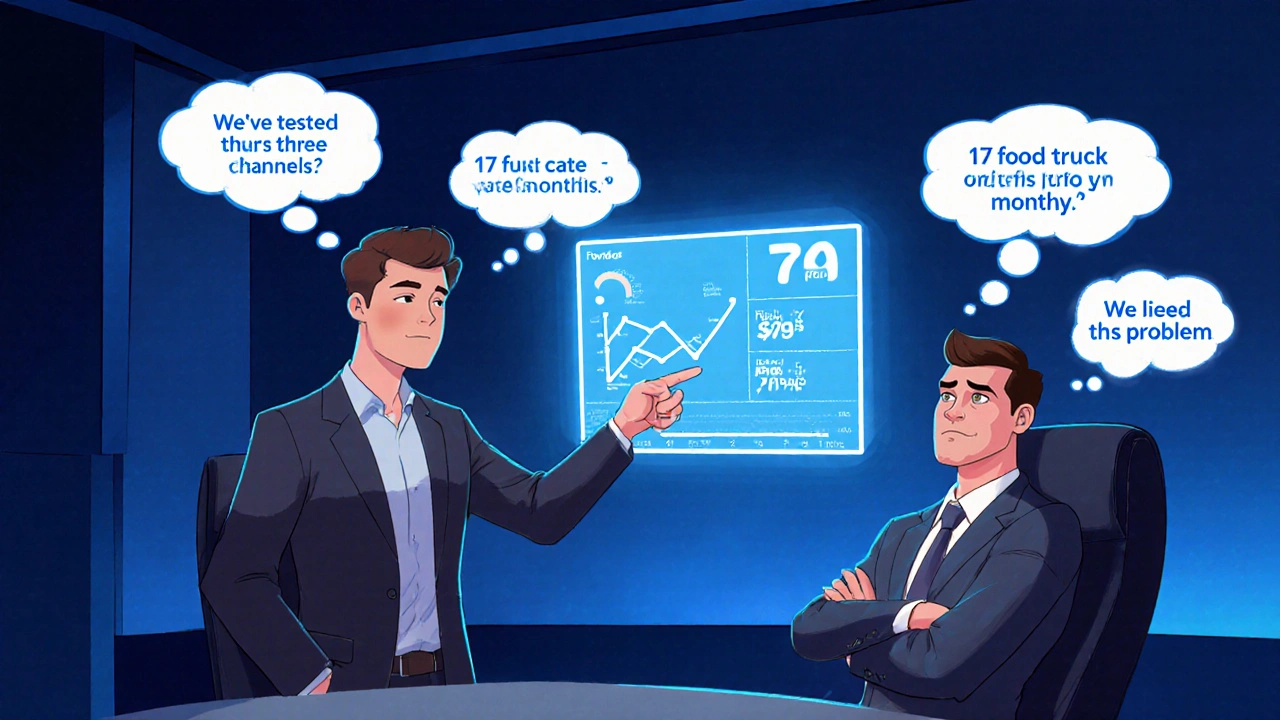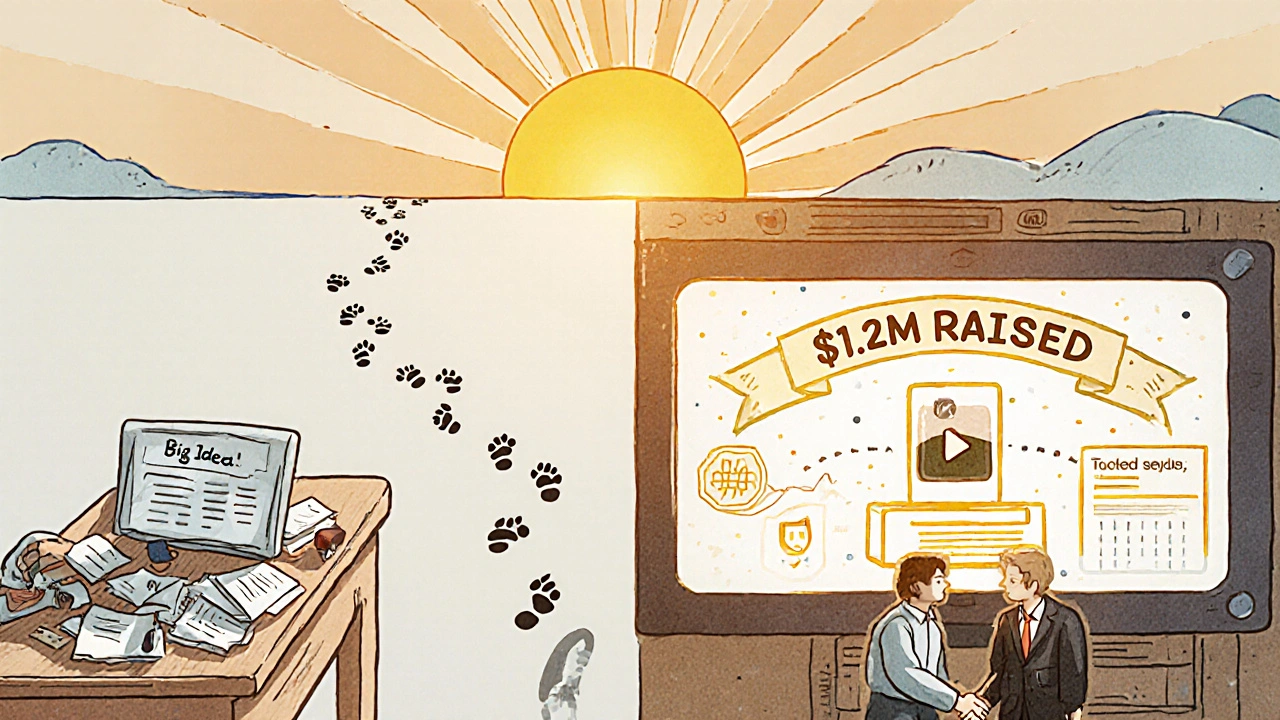Entrepreneurship Capstone: How to Build a Pitch Deck and Crush Investor Q&A
 Sep, 10 2025
Sep, 10 2025
Most startup founders think their idea is the hardest part. It’s not. The real challenge? Getting someone to believe in it enough to give you money. That’s where your pitch deck and investor Q&A come in. A great idea with a weak pitch dies. A solid pitch for a good idea? That gets funded.
What a Pitch Deck Actually Needs
A pitch deck isn’t a business plan. It’s not a 40-slide PowerPoint full of text. It’s a visual story that answers one question: Why should I invest $500,000 in you right now?
Top investors see 50+ decks a week. Yours has 7 seconds to grab attention. Here’s what actually works:
- Problem - Not ‘there’s a market,’ but ‘57% of small businesses lose $12,000 a year because they can’t track inventory.’ Be specific. Use real data.
- Solution - Show your product. Not a mockup. A live demo video or screenshot of your app working. If you don’t have one, show a prototype with real user feedback.
- Market Size - TAM, SAM, SOM. Don’t say ‘$10 billion market.’ Say ‘$1.2 billion in North America for restaurants that still use paper logs.’
- Business Model - How do you make money? Subscription? Transaction fee? Show your pricing page. Show your conversion rate. Show your CAC and LTV.
- Traction - Revenue? Users? Partnerships? Even if it’s $3,000 in sales last month, show it. Investors care about momentum, not just potential.
- Team - Not ‘we’re passionate.’ Show who you are. ‘Sarah ran logistics for 3 years at Shopify. Mark built the AI engine behind a $20M SaaS tool.’
- Ask - Be clear. ‘We’re raising $750,000 for 10% equity. $500K for product, $200K for sales, $50K for legal.’
Keep it to 10-12 slides. No more. If you need 15, you’re over-explaining. Cut the fluff. Every slide must move the needle.
The Investor Q&A: It’s Not an Interview. It’s a Stress Test.
After your pitch, the real work begins. Investors don’t ask questions to learn. They ask to find your weak spots. They want to know if you’ve thought about the hard stuff.
Here are the 5 questions they always ask - and how to answer them without sounding scripted:
- ‘What’s your biggest risk?’ - Don’t say ‘competition.’ Say ‘our biggest risk is customer acquisition cost rising faster than we projected. We’ve tested three channels. Paid ads gave us a 2.3x ROI. Referrals gave us 5.1x. We’re shifting 70% of budget to referrals.’ Show you’ve tested it.
- ‘Why now?’ - ‘Because the old way is broken. In 2023, 80% of small businesses still used Excel for payroll. Now, with new tax laws and real-time reporting rules, they’re forced to upgrade. We’re the only tool built for this exact moment.’
- ‘Who’s your worst competitor?’ - Don’t trash them. Say ‘We compete with QuickBooks for small businesses. But they’re a generalist. We’re built for one thing: inventory tracking for food trucks. We’re 3x faster, and our customers churn 80% less.’
- ‘What if you don’t hit your numbers?’ - ‘We’ve modeled three scenarios. If we hit 60% of revenue targets, we can extend runway by cutting non-essential dev work and focusing on high-LTV customers. We’ve already identified 12 clients who’d pay upfront for early access.’
- ‘Why us?’ - This is your moment. ‘Because we’ve lived this problem. I spent two years working in a restaurant that lost $8,000 a month to spoilage. We built this tool with 17 food truck owners. They’re our first 10 customers. They’re paying $299/month. And they won’t switch.’
Practice these answers out loud. Record yourself. Watch it back. If you sound rehearsed, you’re not ready. Investors want authenticity, not perfection.
What No One Tells You About Investor Meetings
Most founders think the meeting ends when they say ‘thank you.’ It doesn’t. The real decision happens after.
Investors talk. They compare. They remember how you handled the hard questions. Here’s what separates the funded from the forgotten:
- Don’t over-promise. If you say ‘we’ll be in 500 stores by Q3,’ and you’ve only got 3, you lose credibility. Say ‘we’re in 3 stores and have LOIs from 12 more.’
- Own your gaps. ‘We don’t have a CMO yet’ is fine. ‘We don’t have a CMO, but we’ve hired a fractional one from Y Combinator’s network and will bring on a full-time person at $150K once we close this round.’
- Know your numbers cold. If they ask ‘what’s your burn rate?’ and you have to think for 5 seconds, you’ve already lost. Know your monthly expenses, runway, and unit economics down to the dollar.
- Bring a co-founder. One person can’t answer every question. If you’re the CEO, bring your CTO or head of product. Investors want to see a team, not a solo act.

Common Pitch Deck Mistakes (And How to Fix Them)
Here’s what kills deals before they start:
- Too much text. If you have more than 20 words per slide, cut it. Use images, icons, charts. Investors read fast.
- Generic metrics. ‘We’re growing 30% MoM’ - without context, that means nothing. Say ‘We grew from 120 to 156 users in 30 days - all from organic Instagram posts.’
- No clear ask. If you don’t say how much you want and what you’ll do with it, they assume you don’t know.
- Ignoring unit economics. If your CAC is $120 and your LTV is $130, you’re not a business. You’re a charity. Show the math.
- Not having a follow-up plan. After the meeting, send a 1-sentence email: ‘Thanks for your time. Here’s the deck again. We’re targeting a close by Nov 15. Let me know if you’d like to meet again.’
Real Example: What a Winning Deck Looked Like
A food tech startup from Austin raised $1.2M with a 9-slide deck:
- Problem: ‘Food trucks lose 22% of inventory to spoilage. No affordable tool tracks this.’
- Solution: Video of their app scanning QR codes on produce, auto-calculating waste.
- Market: ‘200,000 food trucks in the U.S. 60% use paper logs.’
- Product: Screenshot of dashboard showing real-time waste alerts.
- Traction: ‘17 paying customers. $5,100 MRR. 94% retention after 90 days.’
- Business Model: $299/month per truck. 3-month minimum contract.
- Team: ‘Founder ran logistics for a regional grocery chain. CTO built a similar system for Walmart.’
- Ask: ‘$1.2M for 12%. $800K for product, $300K for sales, $100K for compliance.’
- Next Steps: ‘Closing in 30 days. We’ve got term sheets from 2 other funds.’
They didn’t have a fancy logo. No animations. Just facts, clarity, and confidence.

What Comes After the Pitch
Getting the meeting is half the battle. Closing the round is the other half.
After your pitch:
- Send the deck within 24 hours.
- Follow up in 5 days if you haven’t heard back. Not ‘just checking in.’ Say ‘We’ve added 3 new customers since we met. Here’s the updated traction slide.’
- If they say no, ask why. Not ‘can you give feedback?’ Ask ‘What’s the one thing that would make you say yes?’
- Keep your network warm. Even if they don’t invest now, they might refer you to someone who does.
The best founders don’t just pitch. They build relationships. They stay in touch. They update investors with wins - even small ones. That’s how you turn a ‘no’ into a ‘yes’ six months later.
Final Thought: It’s Not About the Deck. It’s About the Mindset.
Your pitch deck is a mirror. It shows whether you’ve thought deeply about your business - or just memorized a template.
Investors don’t fund ideas. They fund people who’ve done the work. Who’ve talked to customers. Who’ve tested assumptions. Who’ve failed and adjusted.
If your deck feels like a sales pitch, rewrite it. If it feels like a story of a problem you’ve lived, solved, and proven - you’re ready.
How long should a pitch deck be?
A strong pitch deck is 10 to 12 slides max. Investors skim. If you go beyond 15, you’re losing attention. Focus on clarity, not completeness. Save the detailed financials for the appendix - only send them if asked.
What’s the most common mistake founders make in investor Q&A?
Avoiding hard questions. Founders often give vague answers like ‘we’re working on it’ or ‘the market is big.’ Investors want specifics: numbers, tests, timelines. If you don’t have the answer, say ‘we haven’t tested that yet, but here’s how we plan to find out.’ Honesty builds trust.
Should I include financial projections in my pitch deck?
Yes - but keep them simple. Show 3-year revenue, gross margin, and cash burn on one slide. Don’t show 10-year forecasts. They’re fantasy. Investors care about your assumptions: How many customers will you get? At what cost? What’s your retention? Prove you’ve thought through the math, not just guessed.
Do I need a prototype to raise money?
Not always - but you need proof of demand. A prototype helps, but so does a list of 10 customers willing to pay. Or a waitlist of 500 people. Or a signed LOI from a pilot client. Investors fund traction, not ideas. If you can show people are already using or paying for your solution, you’re ahead of 90% of founders.
How do I know if my pitch deck is good enough?
Test it on someone who doesn’t know your business. Give them 60 seconds to read it. Then ask: ‘What do you think we do? How do we make money? What’s the big risk?’ If they can’t answer clearly, your deck needs work. If they get it instantly, you’re on the right track.
Rakesh Kumar
October 30, 2025 AT 23:57This is the most practical pitch deck guide I've ever read-no fluff, just blood, sweat, and real numbers. I showed this to my co-founder and we rewrote our entire deck in two hours. We went from 18 slides to 9. Got our first investor meeting next week. Thank you.
Michael Gradwell
October 31, 2025 AT 04:01Everyone says 'show traction' but 90% of founders just paste fake growth charts. If your MRR is under $5K and you're asking for $1M, you're not a founder-you're a con artist.
Ian Maggs
November 1, 2025 AT 08:02It’s not about the deck… it’s about the mindset… and the humility… and the relentless iteration… and the willingness to be wrong… and the courage to admit it… and the discipline to keep going anyway…
Priyank Panchal
November 2, 2025 AT 10:21You think this is hard? Try raising money in India with no connections. No one here cares about your traction. They care about your last name. Your caste. Your uncle’s friend who knows a VC. This guide is for Silicon Valley elites. Real entrepreneurs are still sleeping in hostels with no internet.
Ronnie Kaye
November 2, 2025 AT 20:33Bro, I just watched a founder cry after a pitch because an investor said 'your CAC is too high.' That’s not a business-it’s a therapy session with equity. But hey, at least he had a deck. Most of my friends are still using Canva templates with clipart of rockets.
Flannery Smail
November 3, 2025 AT 05:35Everyone’s obsessed with 10-slide decks but what if your idea needs 15? What if you’re building quantum AI for bee pollination? Should you cut the slide about how bees are dying because of glyphosate? Nah. That’s the whole point. Stop following rules. Build something worth explaining.
Samuel Bennett
November 4, 2025 AT 22:48Did you know the IRS has a 2024 rule that makes any SaaS company using 'MRR' in their deck liable for tax fraud if they don't file Form 8832? Also, Y Combinator is secretly owned by the CIA and all pitch decks are scanned for crypto keywords. You think you're pitching to VCs? You're pitching to the NSA.
Wilda Mcgee
November 6, 2025 AT 08:27I love how this breaks it down like a cooking recipe: problem = onions, solution = garlic, traction = the sizzle. I showed this to my 16-year-old niece who’s building a TikTok shop for handmade earrings. She said, 'So I just need to show people actually buying them?' YES. Exactly. That’s the whole damn thing.
Ryan Toporowski
November 8, 2025 AT 01:20Just sent my deck to 3 angels today. Used the exact structure from this post. One replied: 'This is the clearest pitch I’ve seen all year.' 🥹 I’m crying. Not because I got funded… but because I finally stopped pretending I knew what I was doing. Thank you. 🙏🔥
Bill Castanier
November 9, 2025 AT 02:06Clarity over creativity. Substance over style. Action over aspiration. These are not suggestions. They are non-negotiables. If you cannot articulate your business in under 60 seconds, you have not done the work.
Chuck Doland
November 10, 2025 AT 21:27The notion that 'investors fund people, not ideas' is a romantic myth. Investors fund predictable returns. They fund teams with prior exits. They fund founders who can articulate unit economics with zero hesitation. The rest are noise. This guide is excellent-but it’s not for everyone. It’s for those who’ve already earned the right to be heard.
Jen Becker
November 12, 2025 AT 17:50I spent six months on my deck. Rewrote it 23 times. Got rejected by 17 VCs. Then I added one line: 'We lost $12,000 last month because we didn’t know what we were doing.' They all called back. Turns out, vulnerability is the new hustle.
Madeline VanHorn
November 13, 2025 AT 19:14Why do people still think a demo video is enough? I’ve seen decks with 100% fake screenshots. Like, the app doesn’t even exist. Just a Figma mockup with ‘Buy Now’ button. Please. Stop wasting my time.
Glenn Celaya
November 15, 2025 AT 01:29I got funded last year with a 3-slide deck. One slide said 'I know people.' Second slide: 'They’ll pay.' Third: 'Here’s my bank account.' That’s it. You don’t need slides. You need connections. This guide is for people who don’t have any.
Emmanuel Sadi
November 16, 2025 AT 19:15Let’s be real. The only thing that matters is who you know. This whole 'traction' thing is a fairy tale for people who don’t have rich dads. I’ve seen startups with zero revenue raise $5M because the founder went to Stanford and wore a black turtleneck. The deck? A PowerPoint template from 2012. And guess what? They won.
Tony Smith
November 18, 2025 AT 00:59As someone who has reviewed over 300 pitch decks for incubators, I can confirm: the most compelling decks are not the most polished. They are the ones where the founder’s voice comes through-raw, unedited, slightly nervous, but undeniably real. You don’t need to be perfect. You need to be honest. And you need to know your numbers like your own heartbeat.
Chris Atkins
November 19, 2025 AT 04:38Just got a term sheet after using this guide. I didn’t even know what CAC meant three weeks ago. Now I can explain it to a 5-year-old. Thanks for making this feel possible. I’m not a genius. I just followed the steps.
Nicholas Carpenter
November 19, 2025 AT 08:18One thing this doesn’t mention: after you get the meeting, don’t show up alone. Bring someone who can say 'I handled the engineering side' or 'I did the customer interviews.' Investors want to see a team. Not a lone hero. You’re not Elon. You’re just trying to survive. Bring your friend.